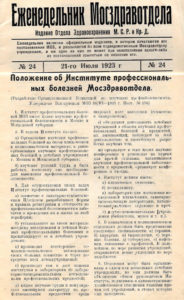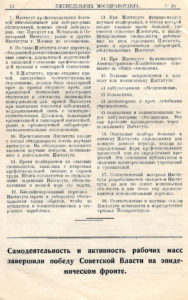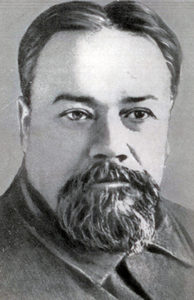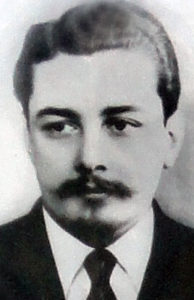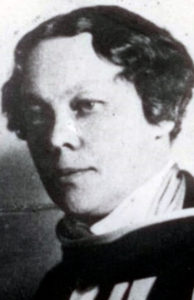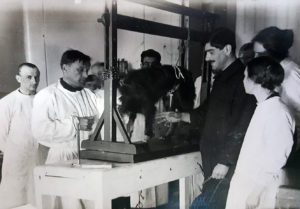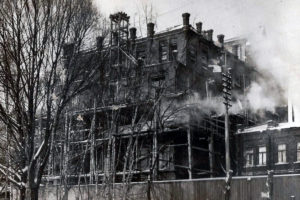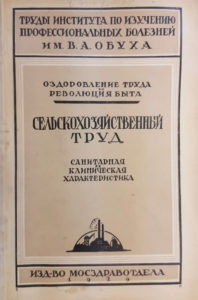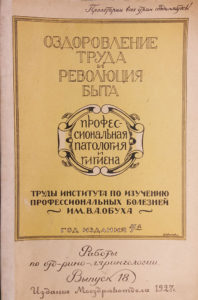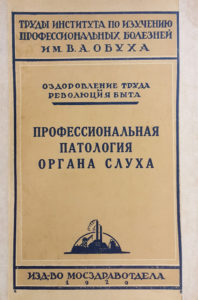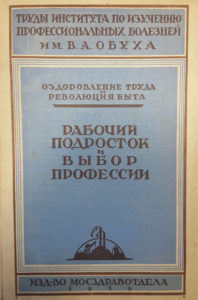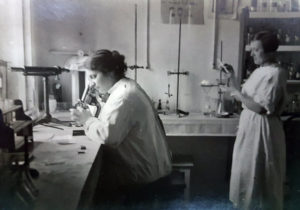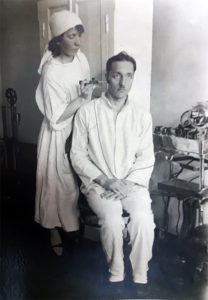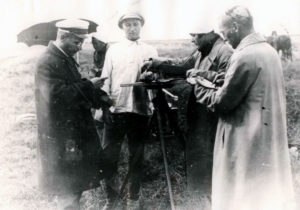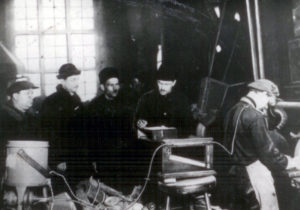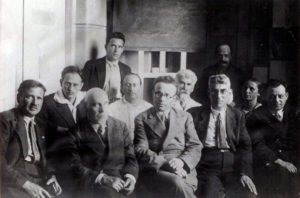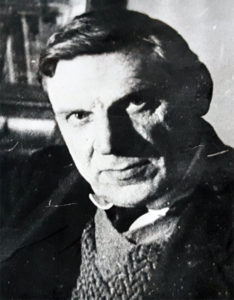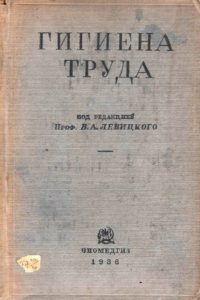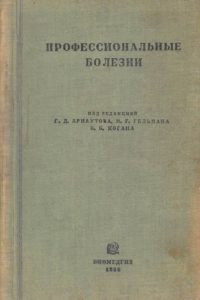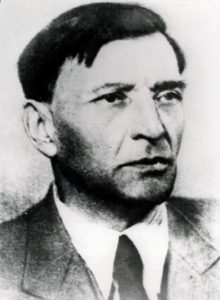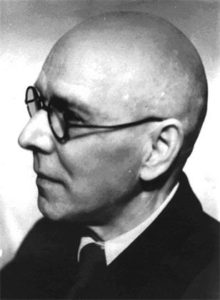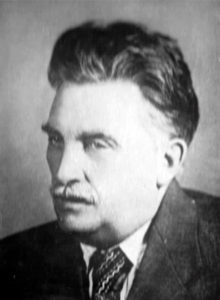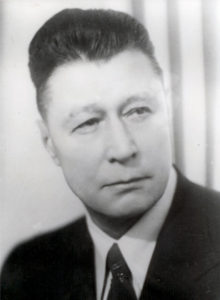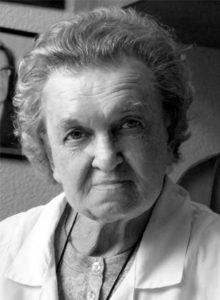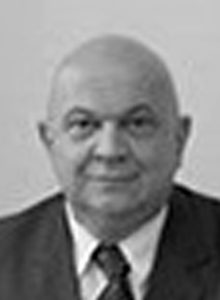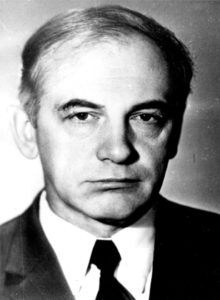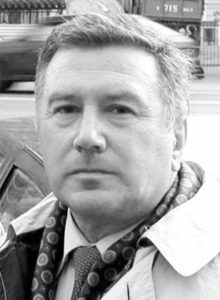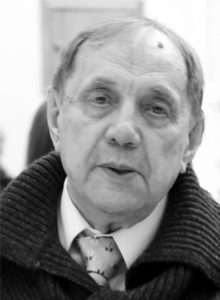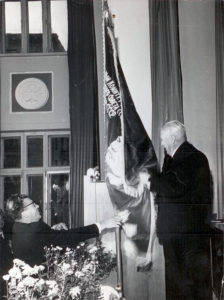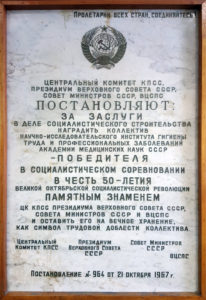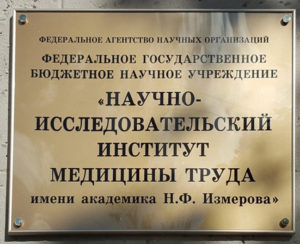Date of creation
June 20, 1923
Institute Address in 1923
14, Vorontsovo Pole street, Moscow, Evangelical Hospital
Titles of Institute since 1923
- “Institute of Occupational Diseases of Moscow Public Health Department” (1923)
- “Research Institute of Occupational Diseases named after V.A.Obukh” of Moscow Public Health Department (1923-1934)
- “Research Institute of Occupational Diseases named after V.A. Obukh» of the Russian Soviet Federated Socialist Republic People’s Commissariat of Health (1934-1935)
- “All-Union Scientific Research Institute of Occupational Hygiene and Diseases named after V.A. Obukh” of the Union of Soviet Socialist Republics People’s Commissariat of Health (1935-1940)
- “Central Institute of Occupational Diseases” of the Union of Soviet Socialist Republics People’s Commissariat of Health (1940-1944)
- “Scientific Research Institute of Occupational Hygiene and Diseases” of the Union of Soviet Socialist Republics Academy of Medical Sciences (1945-1992)
- “Research Institute of Occupational Health” of the Russian Academy of Medical Sciences (1992-2002)
- State Institution “Research Institute of Occupational Health” of the Russian Academy of Medical Sciences (2002-2008)
- Establishment of the Russian Academy of Medical Sciences “Research Institute of Occupational Health RAMS” (2008-2011)
- Federal State Budgetary Institution “Research Institute of Occupational Health” of the Russian Academy of Medical Sciences (2011-2014)
- Federal State Budget Scientific Institution “Research Institute of Occupational Health” (2014-2017)
- Federal State Budgetary Scientific Institution “Izmerov Research Institute of Occupational Health» (2017)
Directors since 1923
- Vladimir KONOPLYANKIN (1923-1925)
- Lyudmila BOGOLEPOVA (1925-1931)
- Georgiy ARNAUTOV (1931-1939)
- Alexander DVORKIN (1939-1942)
- Zinoviy SMELYANSKIY (1942-1944)
- Philipp TCHEKHLATY (1944-1948)
- August LETAVET (1948-1971)
- Nikolai IZMEROV (1971-2012)
- Igor BUKHTIYAROV (2012- present time)
Fast process of industrialization of the young Soviet republic in 1920-1930, large-scale construction of enterprises in the metallurgical, mining, machine-building and chemical industries in its different regions demanded the solution of new tasks in the sphere of occupational health. It required the creation of the powerful base of medical and sanitary services for plants and factories, organization of effective fight against occupational diseases in the country.
The question of the establishment of specialized scientific and practical institutions dealing only with these problems was raised by major figures in domestic medicine since the first days our country was formed. As well as at the meetings of the Sanitary Bureau of the Moscow Health Department of the Moscow Soviet of Workers’ and Peasants’ Deputies.
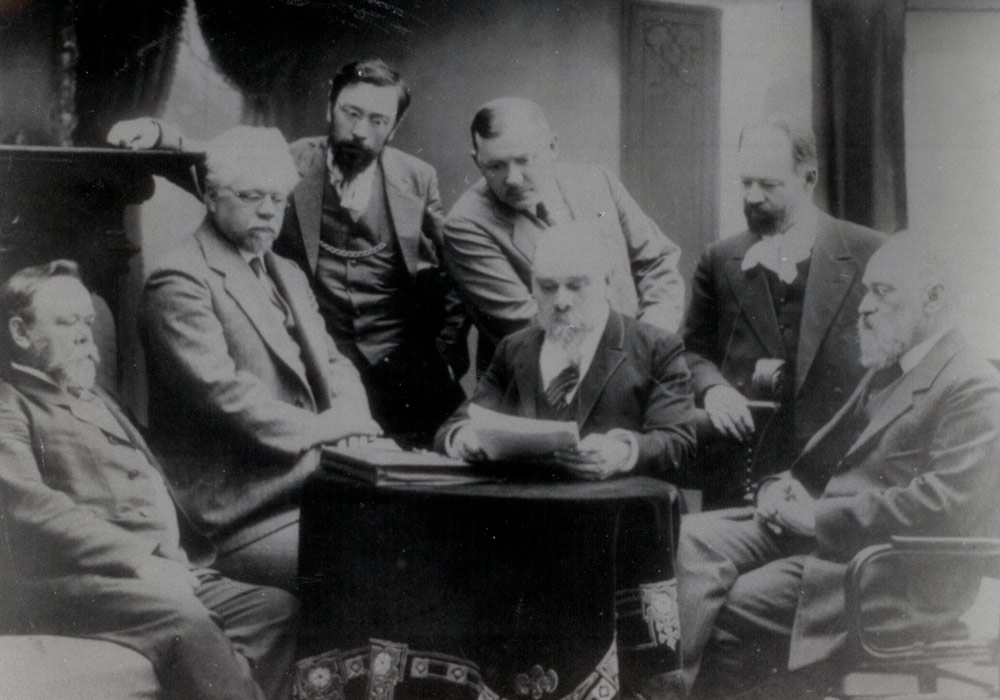
Among the participants: V. Lebedev, P. Kurkin, V. Kiriakov, E. Grigoriev, S. Bogoslovsky, M. Sosnin, V. Levitsky.
As the result, after the report “About the organization of the study of occupational morbidity of workers” (1), presented by the board member L. Bogolepova, and wide discussion of it, the commission was established. This commission included L. Bogolepova, S. Galitsky, A. Ginodman, S. Gurevich, P. Dyakanov, S. Korshun, M. Krol’, P. Nikolsky, D. Uspensky, V. Khesin, S. Shvaitsar and Y. Kats.
On the 14 of June, the commission submitted its opinion for consideration and on the 21st of July, 1923, on the pages of “Weekly of the Moscow Health Department” No. 24 “Regulations on the Institute of Occupational Diseases of the Moscow Health Department” (2) appeared. It was approved on the 20th of June, 1923 by the chief of the Moscow Health Department, Vladimir Obukh with the number 278. The same day the solemn opening ceremony of the
“Regulations on the Institute of Occupational Diseases of the Moscow Health Department”. (Developed by the Organizational Commission for the study of occupational diseases. Approved on the 20th of June, 1923 by the chief of the Moscow Health Department. Decree No. 278).
The Institute was opened on the basis of the former Evangelical hospital, one of the most technically equipped at that time. It was located on Vorontsovo pole street, house No. 14.
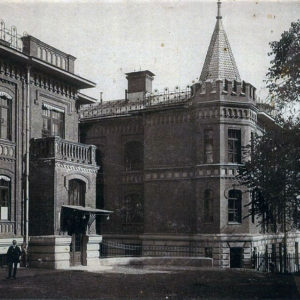
The staff of the institution was approved on the 3rd of September, 1923 (in number of 141 persons) and on the 23rd of August a contest for vacancies was announced.
The Academic Council of the Institute was created on the 23rd of August and it included L. Bogolepova, I. Gelman, S. Gurevich, P. Elistratov, Y. Kats, V. Konoplyankin.
PHOTO 04
The first director of the Institute was Vladimir Konoplyankin (1885-1927). Unfortunately he was seriously ill with tuberculosis and payed little attention to the Institute’s activity practically from the first days of work. He resigned as director in 1925. A year and a half later at the age of 41 years Vladimir Konoplyankin died. In 1925-1931 the director of the Institute was Ludmila Bogolepova (1889-1979), since 1931 till 1939 the director was Georgy Arnautov (1897-1976).
The sanitary division of the Institute started its work from December 1923 and was headed by Aleksandr Smirnov. Being well aware of sanitary and hygienic tasks of the Institute, Aleksandr Smirnov seriously engaged in methodological and methodological questions of the medical examination of employees. For the first research works he choose the factors which have the strongest adverse effect on the organism, such as temperature fluctuations, radiant energy and the most toxic substances occurring in production: lead, petrol, aniline dyes. The scientists of this department also were developing basics of nutrition, general dietetics and muscular fatigue issues of workers in various industrial groups.
The sanitary division of the Institute started its work from December 1923 and was headed by Aleksandr Smirnov. Being well aware of sanitary and hygienic tasks of the Institute, Aleksandr Smirnov seriously engaged in methodological and methodological questions of the medical examination of employees. For the first research works he choose the factors which have the strongest adverse effect on the organism, such as temperature fluctuations, radiant energy and the most toxic substances occurring in production: lead, petrol, aniline dyes. The scientists of this department also were developing basics of nutrition, general dietetics and muscular fatigue issues of workers in various industrial groups.
The first scientific subdivision of the sanitary division of the Institute was physiological laboratory, the specialists of which conducted the first studies on the influence of environmental factors on human health: digestive, cardiovascular and blood systems (I. Razenkov, S. Chechulin, A. Kabanov). A little bit later this subdivision was divided into sections: vivisectional, digestive, neuromuscular (A. Magnitsky), of Isolated organs (A. Kabanov), operating, section of conditioned reflexes, cardiovascular (A. Blinova) and gas exchange section.
Simultaneously with the physiological department other subdivisions were created in the Institute: biochemical department (G. Derviz) with chemical (S. Vavilov) and physico-chemical (S. Vavilov) sections, morphological department (B. Lavrentiev). The department of occupational disease statistics was headed by S. Bogoslovsky – a major specialist in this field in the national medical science.
At the end of 1926 the Institute started with the construction of its own building at the territory of the hospital. According to the plans of the directorate this building was constructed for hygienic department and clinic, as well as all subsidiary divisions.
All the achievements and results of the research works were published by the Institute in the digest “Improvement of Labour and Revolution of the Mode of Life”, specially created by the Moscow Health Department, and published 28 times for the period from 1923 till 1934. In the first issues the following results were published:
- about the occupational morbidity statistics (1923, issue No. 1)
- about the participation of the workers in the improvement of labour (1923, issue No. 1)
- about the methodology of professional pathology studying (1924, issue No. 2)
- about the theory and practice of clinical examination (1924, issue No. 3)
Some issues of the digest “Improvement of Labour and Revolution of the Mode of Life”.
The clinical division of the Institute was created and headed for many years by Izrail Gelman, consisted of several subdivisions: therapeutic (I. Gelman, P. Elestratov) and surgical (I. Golyanitsky) sections, chemical (K. Lavrovsky) and biochemical (Y. Gefter) laboratories, and also X-ray room (L. Golst). Later the following divisions were formed – tuberculous (D. Karpilovsky), nerve division (S. Davidenkov), traumatic (V. Gorinevskaya), gynecological (A. Madzhuginsky), division of professional counseling (A. Pakhomychev), also the laboratories of patanatomies and hematology (E. Freifeld), experimental pathology (E. Bauer), psychophysiology (E. Ruzer).
In addition to the above-mentioned divisions, there was a polyclinic (A. Sapozhnikov), dispensary (R. Zhabotinsky) and a dental office (P. Tikhomirov).
At that time the Moscow Health Department attracted famous specialists of both hygienic and clinical profile. M. Konchalovsky (therapy), V. Ivanov (skin diseases), E. Kurdinovsky (gynecology), N. Shneider (otolaryngologist), I. Lapshina and S. Shveitser (phthisiology), L. Rozenshtein (psychiatry), A. Sysin, Y. Kats, B. Berlin and S. Gurevich (hygiene), and the heads of other large city hospitals – G. Elistratov, M. Ogorodov, S. Galitsky worked as consultants.
From the 1st day of its activity the Institute became ideological and scientific organizational center for prophylactic medical examination of industrial enterprises of Moscow region. During first years of work more then 40 000 workers from 54 enterprises of metalworking, chemical, polygraphic, porcelain, textile, tannery and other industries were examined: at factories “Bogatyr”, “Krasny proletary”, “Kauchuk”, “Trekhgornaya manufaktura”, “Serp I molot” and others, as well as at agricultural state farms.
The first research work of new Institute was the examination of workers polygraphist. This work was approved at the meeting of the head physicians of medical institutions of Moscow because for its fulfilment it was necessary to additionally attract practical doctors of the region. In the first issue of Moscow medical journal for 1924 it was written that Moscow Institute “started researching occupational diseases”. In the same issue the director’s assistant on the medical part I. Gelman wrote that the Institute carried out a great “organizational and ideological” work despite delayed equipment, repair and staffing. The articles “Tasks of the Institute for the Study of Occupational Diseases named after V. Obukh” of L. Bogolepova and the article “To the question about the coordination of works on studying and combating occupational soreness” of Y. Kats became fundamental in the scientific strategy of the Institute.
From the first days of activity of the Institute its leadership paid great attention to the organization and holding conferences, seminars and working meetings, as well as the participation at the hygienic exhibitions. On the initiative of the Institute for the Study of Occupational Diseases named after V. Obukh the 1st All-Union conference on occupational hygiene and equipment took place in 1925.
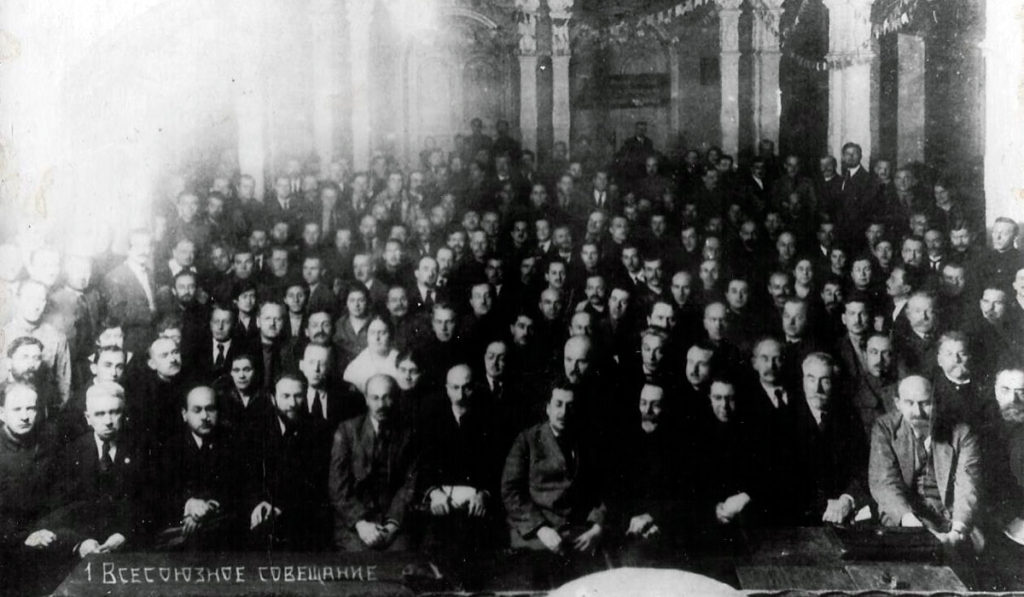
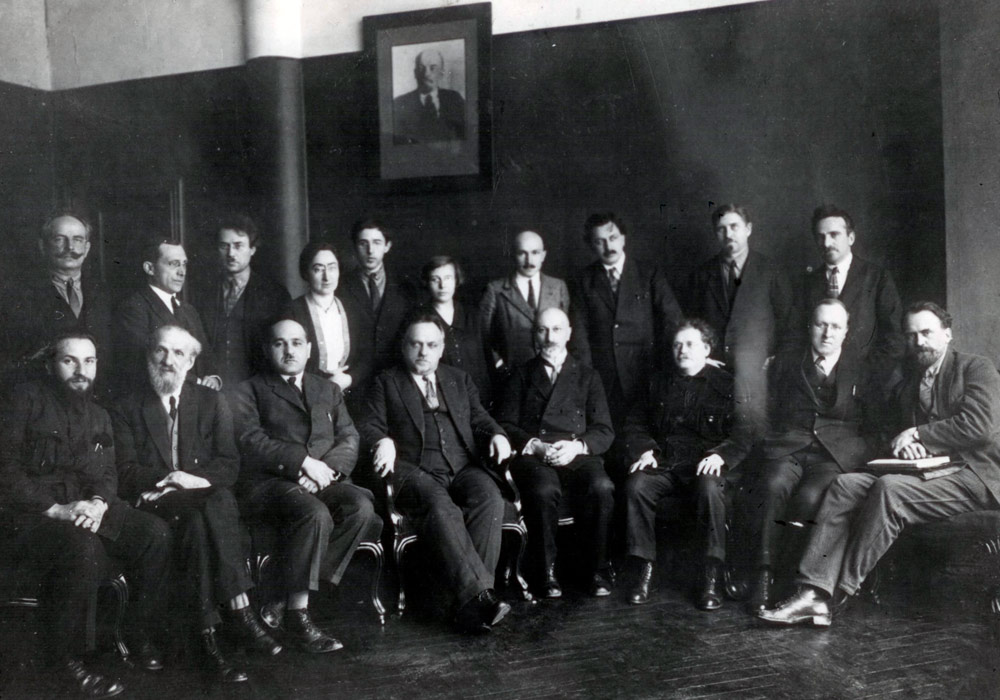
Besides scientific and clinical departments and laboratories in the Institute there were organized “Scientific museum” (reference), library of scientific and popular literature, night health resort and diet canteen. Night health resort and diet canteen were aimed at helping the workers to work without interruption, get a good rest and receive a dietary meal on various medical indications.

Big changes in the development of production’s modernization, consolidation of enterprises and construction of new industrial giants of the second half of the XX th (twentieth) century make corrections in the priorities of scientific activity of the Institute, which begins to serve the leading branches of the industry, such as ferrous metallurgy, chemical and textile industries, mechanical engineering. It switched the halo of the work of our institution from the Moscow region to the territory of the whole country.
The sanitary part of the institute cardinally changes: several separate hygienic departments and laboratories, dealing with the most important branches of industry and agriculture are formed on its basis. After major reorganization of the Institute of labor protection of the All-Union Central Council of Trade Unions, the part of its’ divisions are transferred to the Institute named after V. Obukh. The clinical subdivision of occupational injuries appeared, the laboratory of professional counseling was seriously expanded, psychotechnical laboratory appeared too (N. Levitov, V. Mikulsky, A. Khodzhash). In its scientific activity the questions of study of female labor appeared, study of new problems of general and industrial toxicology. Especially during this period of time the great importance was given to the scientific problems of the conditions of agricultural labor.
In scientific research the subjects of physiological problems of labor in separate occupations began to prevail. The purpose of it was a more detailed study of the possibilities of labor’s rationalization, both from the physiological and hygienic points of view. The last led to the positions of the standardization of labor from various medical points of view.
In these years the institute is being filled with invaluable staff of hygienists and scientists of other neighboring specialties – L. Khotsyanov, T. Pik, Z. Smelyansky, S. Cherkinsky, S. Shakhnovsky, S. Volter. The toxicologist Nikolay Pravdin joins them. In 1935 after the integration with other institutions the Institute got a new title – the Central Institute of Occupational Health and Diseases named after V. Obukh under People’s Commissariat for Health Care of the USSR. This gave the institution a leading status of research work in the country. The institute was being filled with new names again: V. Levitsky, A. Letavet, A. Malysheva (all hygiene), M. Bykhovskaya and O. Khalizova (sanitary chemistry).
By the end of 30th years the Institute became the biggest scientific and clinical institution of the country on the questions of workers’ health preservation with multiple and many-sided network of multidiscipline directions in the research work. Accumulated materials allowed in 1939 to develop the first general law “Sanitary requirements for design and construction of industrial enterprises”.
In 1936 two major scientific works were created: the textbook “Occupational health” edited by V. Levitsky, and the textbook “Occupational diseases” edited by G. Arnautov, I. Gelman and B. Kogan.
Since its establishment the Institute is actively developing the prophylactic direction of domestic medicine, being scientific and methodological center for integrated study of industrial and occupational factors’ influence on the workers’ health and for the development of scientifically sound ways to improve working conditions with the aim to maintain and strengthen the workers’ health, to prolong their life, to prevent and treat both occupational and work-related diseases.
Since the first days of the Great Patriotic War the employees of the Institute joined the ranks of the defenders of our homeland and joined the work for the benefit of the people, the front and the Victory. Many of them went to the front by volunteers and served as part of the sanitary-epidemiological services of armies and fronts, others remained in the occupied territories and, together with partisan detachments, brought the defeat of Fascist Germany closer.
The scientific potential of the Institute by this time was represented by the largest hygienists, toxicologists, specialists of many close specialties (biologists, chemists, physiologists) and clinicians of different profiles. All this gave the possibility to conduct the activities to provide scientific and methodological assistance to medical facilities of the defense plants in the disease prevention of the workers, occupational injuries, as well as in the development of safe working methods at munitions manufacturing plants.
In October 1941 the main part of scientific potential of the Institute was evacuated to Sverdlovsk (A. Letavet, L. Khotsyanov, R. Leites, O. Khalizova, T. Karacharov, N. Pravdin, Z. Smelyansky, A. Dvorkin). The regions of the coverage have become the defense enterprises of Ural, Western Siberia and Central Asia.
The group of scientists of the Institute, under the guidance of the professors L. Khotsyanov and T. Karacharov, developed and implemented a ventilation system in welding and prefabricated manufactories that helped to eliminate the incidence of asthmatic bronchitis among the workers. The team of researchers (L. Khotsyanov, V. Krantsfeld, T. Karacharov and O. Khalizova) was awarded a badge “Excellent worker of the socialist competition of the tank industry” for this work.
Applying clinical and physiological research methods available in the field conditions, the group of specialists under the guidance of A. Letavet and E.Dragichina, on the order of the Ural military district, managed to clearly develop the main proposals on the regime and the load, that let our troops on the front line pass faster swampy terrain when the enemy was approaching, minimizing losses.
The employees of the Institute of Occupational Health and Diseases named after V. Obukh provided enormous advice to many institutions of practical health care in Stalingrad, Dnepropetrovsk, Astrakhan. They made more then 100 expedition trips to the different defense enterprises of the country.
Only the staff of the Clinic of occupational diseases of the Institute remained functioning in Moscow. In 1941 it was re-profiled in a hospital for the treatment of the wounded, constantly coming from the front line. Occupational pathologists of the Institute: S. Genkin, M. Evgenova, E. Drogichina, A. Kisel, A. Resnikov, E. Samakhovskaya worked together with the medical staff of the hospital.
During the war years 1500 patients with occupational poisoning and diseases.
The issues of reduction of occupational morbidity, especially industrial poisoning, among teenagers, involved in the work of defense enterprises, got an important place in the scientific work of the scientists of the clinic.
A special department named “working teenager” was established at the initiative of professor E. Medvedovsky. During the war years almost 15 thousand children and teenagers, working at 90 factories and plants of defense industry, were examined. Due to this work the conditions and the regime of their labor were significantly improved, and even insignificant violations of the teenagers’ labor law become a rarity.
With the use of new paint and varnish materials, when painting aircraft and engines in aircraft industry, there were new cases of heavy chemical poisonings that had not been studied before.
That problem was solved by the employees of the Institute under the guidance of N. Rosenbaum. In the shortest possible time causal components of the chemicals used were elucidated, eliminated from their composition or significantly reduced in concentration. Due to correctly and timely work carried out it became possible to reduce the number of occupational poisonings (more than 17 times) and prevent their development.
At the initiative of the Institute, the holding of scientific sessions on the questions of occupational health and diseases was restarted. The first session took place in Sverdlovsk in May, 1943, and the scientific session of all specialized scientific institutions and chairs of medical educational institutes took place in January 1944. During the session not only the results of hygienists’ and occupational pathologists’ activity on the improvement of working conditions at defense industry enterprises were summarized, but also the results of scientific developments and research. The scientists of our Institute made the reports on the results: the issues of industrial toxicology (N. Pravdin, S. Genkin, I. Ravkin), on allergology (N. Vedrov) and on other scientific directions of occupational health and diseases. Also the employees of the Institute A. Letavet, L. Khotsyanov, A. Arkhipov, E. Vorontsova, S. Kaplun, E. Khukharina, T. Karacharov and many other scientists wrote a lot periodic about the problems and methods of the reduction of occupational morbidity and poisoning of workers in the defense industry.
In the postwar years the Institute of Occupational Health and Diseases named after V. Obukh under People’s Commissariat for Health changes its subordination. When the Academy of Medical Sciences of the USSR was established in 1944 the Institute was reassigned to this new organization (3), as well as many scientific institutions of clinical, medico-biological and hygienic profile. (annex No. 2 to the Regulation of the Council of People’s Commissars dated June 30th, 1944, No. 797). Having passed a complex way of reorganizations and change of its leadership since 1939 till 1948, Science Research Institute of Occupational Health and Diseases of the Academy of Medical Sciences of the USSR preserved its scientific potential and desire to benefit in the improvement of working conditions. In these difficult years for the country the Institute was headed by: A. Dvorkin (1939-1942), Z. Smelyansky (1942-1944) and F. Chekhlaty (1944-1948). In 1948 Avgust Letavet (4) was appointed the director of the Institute. He was going to fully resume the research work of the institution, considerably reduced in volume and in scientific directions.
After 1945 the material and technical equipment of the Institute has significantly improved. A large number of new specialists came to the Institute, and in 1957 the staff moved to a new spacious building. In 1960 an annex to the building was made, and in 1972 the 8-storey building of the clinic for occupational diseases was built.
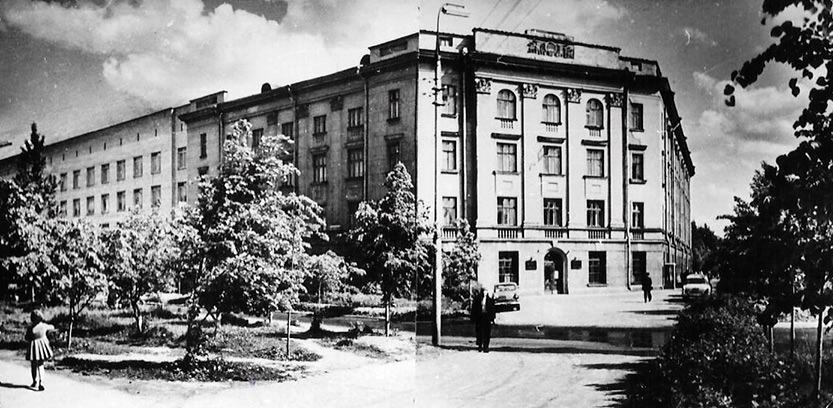
With the development of the scientific and technological revolution in the middle of the 20th century the Institute faces absolutely different tasks. Previously unknown adverse factors of the work environment appeared – vibration, ionizing and non-ionizing radiation, new biological and chemical substances. In this connection there was a need for serious and detailed study of them and development of comprehensive measures to prevent and reduce the occurrence of occupational diseases, scale measures for their prevention.
As in many other scientific institutions dealing with the issues of occupational health, all research and practical development went in the sectoral and factorial directions in our Institute.
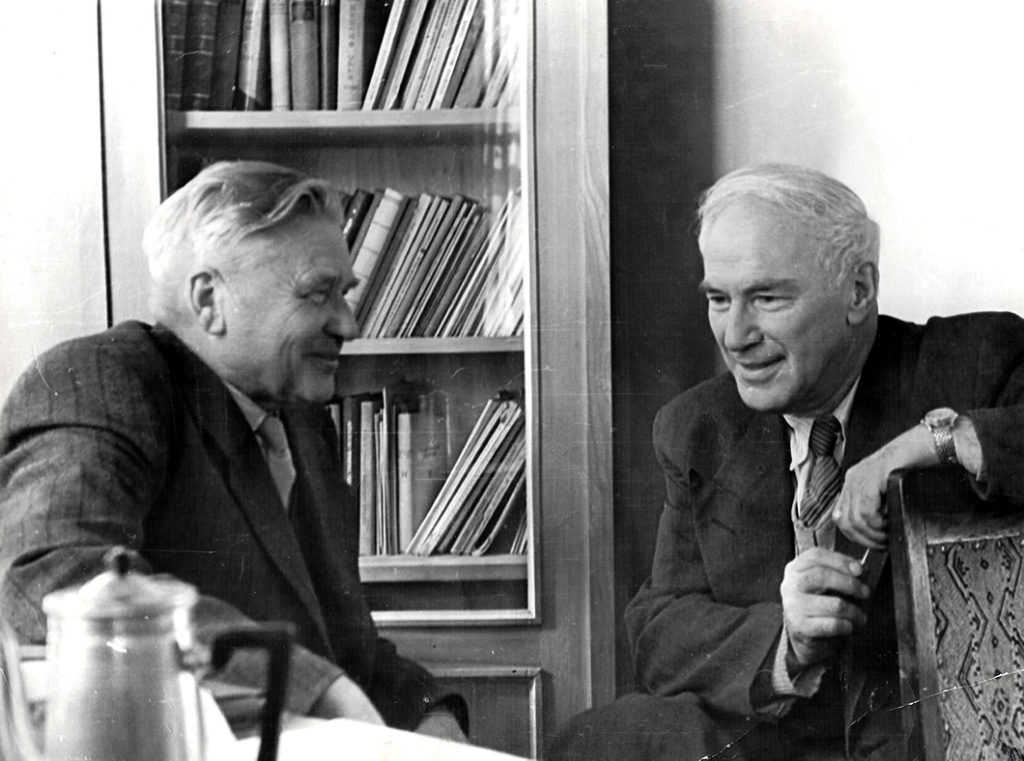
The scientific work on the complex or sectoral research direction at the Institute was carried out by the laboratory of industrial research. Later it was renamed to the laboratory of occupational health in certain industries or the complex problems of sectoral occupational health. It was founded by the leading scientists of the Institute – Academician of the Academy of Medical Sciences of the USSR L. Khotsyanov, Professor Z. Smelyansky, Y. Shirokov, at present time the laboratory is headed by N. Golovkova. The research on the study of work conditions in such branch of national economy as chemical, coal and mining industries, ferrous metallurgy, mechanical engineering and construction, were carried out by the employees of the Institute in many regions of our country for many decades. The detailed study of all adverse processes of working conditions was the foundation for the development of activities, which reduce harmful effects and so which reduce the risk of development of occupational disease.
There was also a laboratory of occupational health of medical workers which functioned for a long time and headed by V. Kaptsov.
Social- hygienic and epidemiological research works have been conducted since the foundation of the Institute. During the Great Patriotic War the work in this direction have been conducted at the defense enterprises. In the following years the work expanded and deepened. The time of rapid development of all aspects of the national economy began. Ubiquitous introduction of automation and electronics, scale chemicalization of all industries and agriculture. It was the work in this direction that began to be conducted within the walls of the Institute from the late 50-ies of the last century (L. Khotsyanov, N. Dogle, N. Izmerov, N. Lebedeva, E. Gurvich, G. Rodionova, G. Tikhonova).
The questions of women’s occupational health also were studied at the Institute from its foundation, but the most serious and effective level was achieved at the time of August Letavet. Under his leadership the group of employees started the work on researching the reaction of female and male organisms to different factors of the industrial environment. A great contribution to the improvement of women’s labor has been made by many scientists (E. Kurlyandskaya, Z. Volkova, A. Yablokova, N. Zlobina, O. Sivochalova, G. Golovaneva, T. Morozova, M. Fesenko).
The research work on labor physiology also is one of the earliest in the Institute.
This independent laboratory was formed in 1944 by Professor V. Farfel. The problems which were developed in different years by the scientists of the Institute (D. Shatenshtein, I. Zaidshnur, S. Kosilov, Z. Zolina, S. Gorshkov, Y. Moijkin, V. Matukhin, O. Yushkova, I. Bukhtiyarov) allowed to receive by research and experimental means the important results on studying the influence of factors of the labor process on the functional state of the employee. This made possible to significantly reduce the occupational morbidity of the musculoskeletal system, nervous, respiratory and cardiovascular systems and many other human organs and tissues.
The second direction in research work – factor study of the issues of occupational health – was studied several laboratories of the Institute.
Serious work on industrial toxicology began at the Institute since 1943, with the arrival of the group headed by Professor N. Pravdin. The big part of theoretical and practical directions of the activity of the department of toxicology concerned chemical protection section – limiting the content of harmful chemicals in the air of the work area (F. Shakhnovskaya, O. Arkhipova, K. Sidorov, A. Khalepo, S. Kremneva, A. Korbakova, I. Ulanova, A. Kanarevskaya, I. Sanotsky, L. Burykina, T. Tkacheva). The attention was also paid to the necessity to study the effect of various combinations of chemicals, impact of other factors on the course of intoxication – temperature conditions; inhalation of the mixture of various hydrocarbons with irritants and others.
The laid theoretical and practical foundation of toxicological research provides further progress in the neutralization of macro and micro effects of chemical components of the industrial environment. The value of the received materials is difficult to overestimate. In addition to the scientific and practical component of the prevention of industrial chemical exposure, they represent a powerful information base. The issues of studying the influence of physical factors were always divided into several directions – the impact of industrial aerosols, vibration and noise, meteorological factors and electromagnetic fields and radiation.
In the end of 1952, the first in our country and one of the first in the world the laboratory of electromagnetic fields was created in the Institute by a separate resolution of the Russian Academy of Medical Sciences of the USSR. During many years the laboratory was headed by Professor Gordon and then by Professor Savin who laid the domestic principles of hygienic regulation of the factor.
The important results were achieved in the study of the principles of hygienic regulation of the physical factors and methods of their control. It was proved that while establishing the standards for vibration and noise it is necessary to take into account not only their isolated or combined with other factors action, but also maintaining a sustainable level of efficiency at different work activities, that make them close to the optimum. During recent decades such scientists as G. Suvorov, L. Prokopenko, L. Elovskya, R. Afanasieva, E. Kovalevsky, Y. Paltsev, N. Rubtsova, L. Pokhodzey were working in this direction.
The serious problem of the occupational health clinic, as well as it was before the war, was silicosis and other pneumoconiosis. All the aspects of their occurrence, diagnostics, clinical course, treatment and rehabilitation sharply increased level of pulmonary pathology of dust etiology exacerbated the importance of new scientifically-based preventive measures.
The questions of X-ray diagnostics were successfully solved (K. Molokanov), the questions of different clinical aspects and estimation of functional state with disability examination (S. Genkin, B. Martsinkovsky, A. Rashevskaya, M. Evgenova, V. Sokolov, N. Senkevich, L. Okhnyanskaya and others).
“An important word” in the development of new research on pneumoconiosis was said by pathomorphology (P. Dvizhkov, M. Tolgskaya, V. Fedorova, T. Kochetkova) and experimental work on the pathogenic effect of dust (E. Khukhrina, E. Vorontsova, L. Elovskaya, V. Tkachev).
At the plenary session, totally devoted to the problem of pneumoconiosis, in May 1957 in Moscow, the project of new domestic classification of pneumoconiosis was presented by the group of scientists of the Institute headed by K. Molokanov. That classification was adopted in 1971, 5 years later, and in 1976 the classification was supplemented and became closer to the international one. Later conducted research led to the creation of a new classification in 1996. This classification was systematized not only on the basis of the effect of industrial dust, but also on the developing pathological process in the lungs and the degree of its manifestation by pathomorphological features.
The merit of clinicians and occupational pathologists is also the finding of the clinical variant of the disease of “occupational” bronchial asthma and its non-immune forms, making its classification and development of a complex of specific allergological and immunological diagnostics.
Due to the specialists of our Institute the dust bronchitis was included in the list of occupational diseases in our country in 1970. The first monograph written by M. Evgenova with co-authors and devoted to this disease was edited in 1972.
Significant results in solving occupational problems of dermatology, neurology and diseases of the musculoskeletal system helped to reduce the morbidity of many nosological forms and solve cardinally the questions about the impact of harmful working conditions on the health of the worker. This is a great merit of scientific director of the Clinic for recent years, Professor Ludmila Kuzmina and leading specialists of this unit of the Institute – Professor N. Izmerova, L. Ivanova, T. Lipenetskaya, Doctors and PhD A. Plukhina, T. Burmistrova, V. Druzhinina, Y. Loshilova, V. Suvurova, E. Lashina, G. Lagutina, N. Sorokina, L. Artemova, E. Buryakina, V. Bolshakova and many-many others.
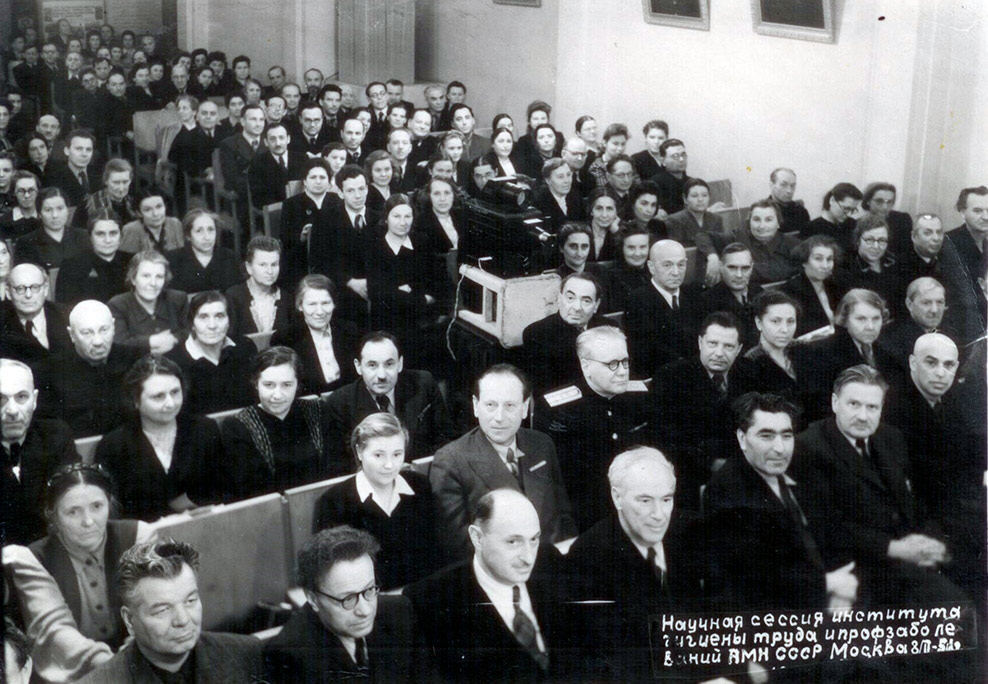
In different years in the Institute, there were major scientists in the field of occupational health:
- Academicians of the Academy of Medical Sciences of the USSR – Sergey Davidenkov, Avgust Letavet, Ivan Razenkov, Lev Khtsyanov
- Academicians of the Russian Academy of Scienses – Boris Velichkovsky, Nikolai Izmerov, Sergey Puzin
- Corresponding Members of the Academy of Medical Sciences of the USSR – Nikolai Vedrov, Elena Vorontsova,Samuil Cherkinsky, Konstantin Molokanov, Natalia Tarasenko
- Corresponding Members of the Russian Academy of Medical of Sciences – Igor Sanotsky, German Suvorov
- Corresponding Members of the Russian Academy of Sciences – Angelina Gus’kova, Valery Kaptsov
- Professors – O. Alekseeva, O. Arkhipova, R. Afanasieva, Z. Volkova, G. Gaeva, I. Gelman, S. Genkin, Z. Gordon, P. Dvizhkov, N. Dogle, A. Dolgov, E. Drogichina, L. Elovskaya, Z. Zolina, L. Ivanova, Z. Izrailson, A. Kapranov, T. Karacharov, A. Kasparov, A. Korbakova, N. Kokorev, V. Kirillov, N. Konchalovskaya, E. Kurlyandskaya, V. Levitsky, P. Lyarsky, E. Malysheva, V. Matukhin, V. Milishnikova, P. Moisejtsev, Y. Mojkin, A. Monaenkova, V. Ozhiganova, V. Pankova, T. Popova, N. Pravdin, D. Pushkin, I. Razumov, A. Rashevskaya, L. Rosanov, V. Rosenblat, A. Roschin, B. Savin, N. Senkevich, O.Sivochalova, N. Simonova, Z. Smelyansky, A. Smirnov, B. Somov, V. Sokolov, L. Tarasova, I. Ulanova, E. Khukhrina, L. Shkarinov and many-many others
For the merits in scientific activity, the Institute was awarded commemorative banner of the Central Committee of the CPSU in 1967, of the Presidium of the Supreme Soviet of the USSR, of the Council of Ministers of the USSR and the All-Union Central Council of Trade Unions, in 1973 – the Institute was awarded with the Order of the Red Banner of Labour.
More than 40 years, the Institute was led by a prominent scientist and hygienist, Academician of the Russian Academy of Sciences Nikolai Izmerov (5). Introduction of the term “occupational health” to the Russian medical terminology also belongs to this great scientist.
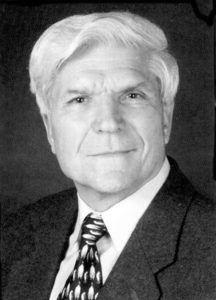
The Institute is one of the co-founders of the Occupational Health Physicians and Specialists Association, co-organizer of the “OCCUPATION and HEALTH” Russian National Congress with International Participation and “OCCUPATION and HEALTH” International Youth Forum.
Since 1957 the Institute has been publishing the Journal “Occupational Health and Diseases” which has got a new title in 1993 – “Occupational health and industrial hygiene” (reference). The Institute is a centre for training highly qualified scientific personnel. The employees and the graduate students of the Institute from 1935 to 2012 defended more then 700 theses — including more than 130 doctoral and 650 master’s theses. The results of the Institute’s research are published in 200 monographs, manuals and textbooks, including more than 50 abroad.
At present time the structure of the Institute comprises 4 main scientific departments: Department on the study of hygienic problems in occupational health, clinical department of occupational and work-related diseases, scientific-coordinating department and the laboratory of postgenomic technologies. The Center for Aviation Medicine is working on the basis of the Institute.
The Institute is the basic organization for the two chairs: chair of occupational health and chair of aerospace and diving medicine of Sechenov University and chair of occupational pathology of Russian Medical Academy of Continuing Education of the Ministry of Health.
Since 2012 the Institute is headed by MD, Professor, RAS Corresponding Member Igor Bukhtiyarov, one of the leading scientists in the field of labor physiology and ergonomics, devoted many years to the study of these issues in the aerospace medicine. At present time such specialists as Academician of the Russian Academy of Sciences Vadim Pokrovsky, RAS Corresponding Members Igor Bukhtiyarov and Igor Bykov, Professors – E. Bonitenko, E. Denisov, N. Izmerova, E. Kovalevsky, L. Kuzmina, T. Lipenetskaya, Y. Paltsev, L. Prokopenjo, N. Rubtsova, I. Kholikov, O. Yushkova, more than 30 D.Sci and Ph.D in medico-biological and pedagogical spheres continue to work at the Institute.
Since March, 2017, by decision of the Academic Council of the Institute and the Federal Agency for Scientific Organizations our Institute has the honorary name of Academician Izmerov.
(3) The decree of the Council of People’s Commissars dated June 30th, 1944, No. 797



